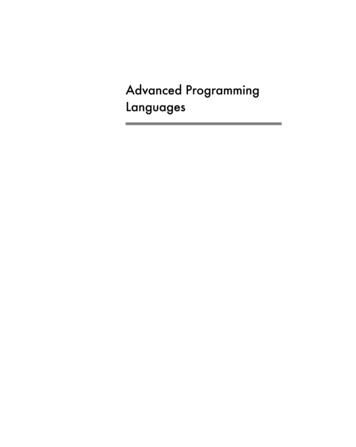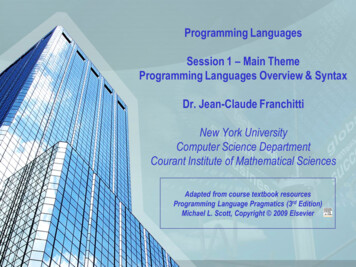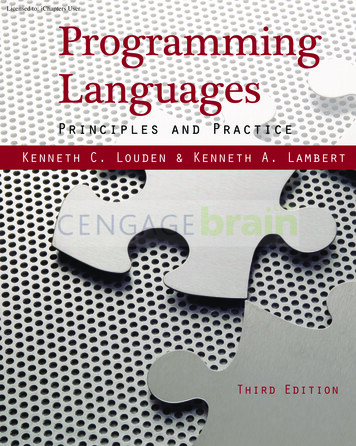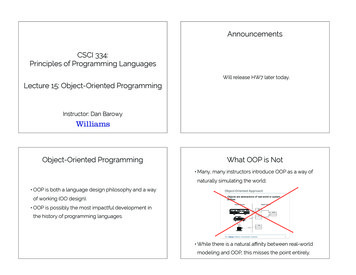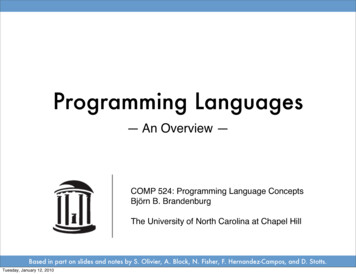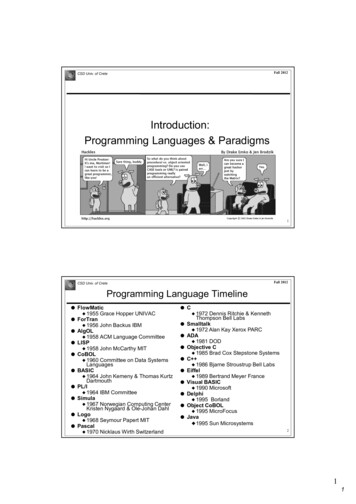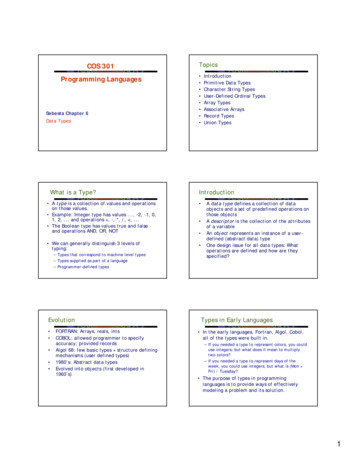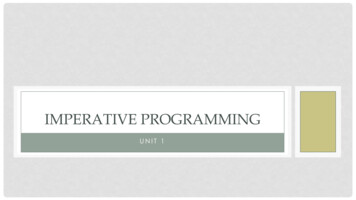
Transcription
IMPERATIVE PROGRAMMINGUNIT 1
Types of computer programming languagesThere are basically three types of computer programming languages, they are Low level programming languages Middle level programming languages High level programming languagesCompiled by Ms. Prajakta Joshi
LOW LEVEL LANGUAGES These are machine dependent programming languages such as Binary(Machine code) and Assembly language. Since computer only understand the Binary language that meansinstructions in the form of 0’s and 1’s (Signals - that can be either High orLow), so these programming languages are the best way to give signals(Binary Instructions) to the computer directly. Machine Code (Binary Language) does not need any interpreter orcompiler to convert language in any form because computerunderstands these signals directly. But, Assembly language needs to be converted in equivalent Binarycode, so that computer can understand the instructions written inAssembly. Assembler is used to convert an assembly code to itsequivalent Binary code. The codes written in such kind of languages are difficult to write, read,edit and understand; the programs are not portable to any othercomputer system.Compiled by Ms. Prajakta Joshi
MIDDLE LEVEL PROGRAMMING LANGUAGE Since, there is no such category of computer programminglanguages, but the programming languages that have features of lowlevel and high level programming languages come under thiscategory. Hence, we can say that the programming languages which havefeatures of Low Level as well as High Level programming languagesknown as "Middle Level" programming language. C programming languages is the best example of Low LevelProgramming languages as it has features of low level and high levelprogramming languages both.Compiled by Ms. Prajakta Joshi
High level programming languages These are the machine independent programming languages, which areeasy to write, read, edit and understand. The languages like Java, .Net, Pascal, COBOL, C , C, C# and other (whichare very popular now to develop user end applications). These languagescome under the high level programming language category. High level programming languages have some special keywords, functionsand class libraries by using them we can easily build a program for thecomputer. Computer does not understand program written in such languages directly,as I have written above that computer understands only Machine code. So,here programming translators are required to convert a high level programto its equivalent Machine code. Programming translators such as Compilers and Interpreters are the systemsoftware’s which converts a program written in particular programminglanguages to its equivalent Machine code.Compiled by Ms. Prajakta Joshi
FEATURES OF HIGH LEVEL PROGRAMMINGLANGUAGES The programs are written in High Level programming languages andare independent that means a program written on a system can berun on another system. Easy to understand - Since these programming languages havekeywords, functions, class libraries (which are similar to English words)we can easily understand the meaning of particular term related tothat programming language. Easy to code, read and edit - The programs written in High Levelprogramming languages are easy to code, read and edit. Even wecan edit programs written by other programmers easily by havinglittle knowledge of that programming language. Since, High Level language programs are slower than Low levellanguage programs; still these programming languages are popularto develop User End Applications.Compiled by Ms. Prajakta Joshi
IMPERATIVE PROGRAMMING Imperative programming is a paradigm of computer programming inwhich the program describes a sequence of steps that change thestate of the computer. Unlike declarative programming, which describes "what" a programshould accomplish, imperative programming explicitly tells thecomputer "how" to accomplish it. Programs written this way often compile to binary executables thatrun more efficiently since all CPUinstructions are themselvesimperative statements. To make programs simpler for a human to read and write, imperativestatements can be grouped into sections known as code blocks.Compiled by Ms. Prajakta Joshi
FEATURES OF IP Procedural programming is a type of imperative programming inwhich the program is built from one or more procedures (alsotermed subroutines. To make programs simpler for a human to read and write, imperativestatements can be grouped into sections known as code blocks.Compiled by Ms. Prajakta Joshi
HISTORY OF IP Earlier computers had fixed programs: they were hardwired to do one thing.Sometimes external programs were implemented with paper tape or by settingswitches.First imperative languages: assembly languages1954-1955: Fortran (FORmula TRANslator)John Backus developed for IBM 704Late 1950’s: Algol (ALGOrithmic Language)1958: Cobol (COmmon Business Oriented Language) Developed by a governmentcommittee; Grace Hopper very influential. The earliest imperative languages were the machine languages of the originalcomputers. In these languages, instructions were very simple, which made hardwareimplementation easier, but hindered the creation of complex programs.Compiled by Ms. Prajakta Joshi
EVOLUTION OF PROGRAMMING MODEL C programming language was developed in 1972 by Dennis Ritchie atbell laboratories of AT&T (American Telephone & Telegraph), locatedin the U.S.A. Dennis Ritchie is known as the founder of the c language. It was developed to overcome the problems of previous languagessuch as B, BCPL, etc. Initially, C language was developed to be used in UNIX operatingsystem. It inherits many features of previous languages such as B andBCPL. Let's see the programming languages that were developed before Clanguage.Compiled by Ms. Prajakta Joshi
EVOLUTION OF PROGRAMMING MODELLanguageYearDeveloped ByAlgol1960International GroupBCPL1967Martin RichardB1970Ken ThompsonTraditional C1972Dennis RitchieK&RC1978Kernighan & Dennis RitchieANSI C1989ANSI CommitteeANSI/ISO C1990ISO CommitteeC991999Standardization CommitteeCompiled by Ms. Prajakta Joshi
SIX GENERATIONS OFPROGRAMMING LANGUAGESGen.1st5th6thPeriod1951-58 1958-64 1964-71 1977-88 1988-1993-TypeLow-level Lowlevel,HighlevelExample embly, BASIC,COBOL, sC e,JavaCompiled by Ms. Prajakta Joshi
IMPERATIVE PROGRAMMING Advantage: Very simple to implement Better encapsulation Bugs free code It contains loops, variablesetc. Disadvantage: Complex problem cannotbe solved Less efficient and lessproductive Parallel programming is notpossibleCompiled by Ms. Prajakta Joshi
ALGORITHM In programming, algorithm is a set of well defined instructions insequence to solve the problem. The word “algorithm” relates to the name of the mathematician Alkhowarizmi, which means a procedure or a technique Software Engineer commonly uses an algorithm for planning andsolving the problems. An algorithm is a sequence of steps to solve a particular problem oralgorithm is an ordered set of unambiguous steps that produces aresult and terminates in a finite timeCompiled by Ms. Prajakta Joshi
QUALITIES OF A GOOD ALGORITHM Input and output should be defined precisely. Each steps in algorithm should be clear and unambiguous. Algorithm should be most effective among many different ways tosolve a problem. An algorithm shouldn't have computer code. Instead, the algorithmshould be written in such a way that, it can be used in similarprogramming languagesCompiled by Ms. Prajakta Joshi
ADVANTAGES OF ALGORITHM It is a step-wise representation of a solution to a given problem, whichmakes it easy to understand. An algorithm uses a definite procedure. It is not dependent on any programming language, so it is easy tounderstand for anyone even without programming knowledge. Every step in an algorithm has its own logical sequence so it is easy todebug.Compiled by Ms. Prajakta Joshi
HOW TO WRITE ALGORITHMS Step 1 Define your algorithms input: Many algorithms take in data to beprocessed, e.g. to calculate the area of rectangle input may be the rectangleheight and rectangle width. Step 2 Define the variables: Algorithm's variables allow you to use it for more thanone place. We can define two variables for rectangle height and rectanglewidth as HEIGHT and WIDTH (or H & W). Step 3 Outline the algorithm's operations: Use input variable for computationpurpose, e.g. to find area of rectangle multiply the HEIGHT and WIDTH variableand store the value in new variable (say) AREA. An algorithm's operations cantake the form of multiple steps and even branch, depending on the value of theinput variables. Step 4 Output the results of your algorithm's operations: In case of area ofrectangle output will be the value stored in variable AREA. if the input variablesdescribed a rectangle with a HEIGHT of 2 and a WIDTH of 3, the algorithm wouldoutput the value of 6.Compiled by Ms. Prajakta Joshi
WRITE AN ALGORITHM TO ADD TWO NUMBERSENTERED BY USER.Compiled by Ms. Prajakta Joshi
WRITE AN ALGORITHM TO ADD TWO NUMBERSENTERED BY USER. Step 1: StartStep 2: Declare variables num1, num2 and sum.Step 3: Read values num1 and num2.Step 4: Add num1 and num2 and assign the result to sum.sum num1 num2Step 5: Display sumStep 6: StopCompiled by Ms. Prajakta Joshi
ALGORITHM FOR AREA OF RECTANGLE STARTInput Length of Rectangle as LInput Breadth of Rectangle as BCalculate Area L * BPrint Value of AreaEND / STOPCompiled by Ms. Prajakta Joshi
PSEUDOCODE Artificial, informal language used to develop algorithms Similar to everyday English Not executed on computers Used to think out program before coding Easy to convert into C program Only executable statements No need to declare variables It’s simply an implementation of an algorithm in the form of annotations andinformative text written in plain English. It has no syntax like any of theprogramming language and thus can’t be compiled or interpreted by thecomputer.Compiled by Ms. Prajakta Joshi
ADVANTAGES OF PSEUDOCODE Improves the readability of any approach. It’s one of the bestapproaches to start implementation of an algorithm. Acts as a bridge between the program and the algorithm orflowchart. Also works as a rough documentation, so the program ofone developer can be understood easily when a pseudo code iswritten out. In industries, the approach of documentation is essential.And that’s where a pseudo-code proves vital. The main goal of a pseudo code is to explain what exactly each lineof a program should do, hence making the code construction phaseeasier for the programmer.Compiled by Ms. Prajakta Joshi
FLOWCHART A flowchart is a diagrammatic representation that illustrates thesequence of operations to be performed to get the solution to aproblem. It can be seen from the definition that a flow always accompanieswith business or transaction. Not all of the flows, however, are appropriate to be expressed byflowcharts, unless these flows are based on some fixed routines andstable links.Compiled by Ms. Prajakta Joshi
FLOWCHART SYMBOLS TerminatorThe terminator symbol represents the starting or ending point of thesystem. ProcessA box indicates some particular operation. DocumentThis represents a printout, such as a document or a report.Compiled by Ms. Prajakta Joshi
DecisionA diamond represents a decision or branching point. Lines coming out from thediamond indicates different possible situations, leading to different subprocesses. DataIt represents information entering or leaving the system. An input might be anorder from a customer. An output can be a product to be delivered. On-Page ReferenceThis symbol would contain a letter inside. It indicates that the flow continues ona matching symbol containing the same letter somewhere else on the samepage.Compiled by Ms. Prajakta Joshi
Off-Page ReferenceThis symbol would contain a letter inside. It indicates that the flowcontinues on a matching symbol containing the same letter somewhereelse on a different page. Delay or BottleneckIdentifies a delay or a bottleneck. Flow Lines represent flow of the sequence and direction of a process.Compiled by Ms. Prajakta Joshi
DRAW A FLOWCHART TO ADD TWO NUMBERSENTERED BY USER.Compiled by Ms. Prajakta Joshi
DRAW FLOWCHART TO FIND THE LARGESTAMONG THREE DIFFERENT NUMBERS ENTERED BYUSER.Compiled by Ms. Prajakta Joshi
COMPILER Actually, the computer cannot understand your program directlygiven in the text format, so we need to convert this program in abinary format, which can be understood by the computer. The conversion from text program to binary file is done by anothersoftware called Compiler and this process of conversion from textformatted program to binary format file is called programcompilation. Finally, you can execute binary file to perform theprogrammed task. Advantages of Compiler A compiler runs much faster. The program can be distributed to many people who don’t havecompilers since a compiler is not needed after compiling occurs. A compiler is stored as an executable file.Compiled by Ms. Prajakta Joshi
COMPILERCompiled by Ms. Prajakta Joshi
PROGRAMMING SENTINEL VALUE In programming, sentinel value is a special value that is usedto terminate a loop. The sentinel value typically is chosen so as to notbe a legitimate data value that the loop will encounter and attemptto perform with. The sentinel value typically is chosen so as to not be a legitimate datavalue that the loop will encounter and attempt to perform with. Forexample, in a loop algorithm that computes non-negative integers,the value "-1" can be set as the sentinel value as the computation willnever encounter that value as a legitimate processing output.Compiled by Ms. Prajakta Joshi
INTERPRETER We just discussed about compilers and the compilation process.Compilers are required in case you are going to write your program in aprogramming language that needs to be compiled into binary formatbefore its execution. There are other programming languages such as Python, PHP, and Perl,which do not need any compilation into binary format, rather aninterpreter can be used to read such programs line by line and executethem directly without any further conversion. Advantage of an interpreter: It immediately displays feedback when it finds a syntax error. The programmer can correct any errors or debug the code before the interpreterevaluates the next line. Disadvantages: Interpreted programs do not run as fast as compiled programs because theprogram must be translated to machine language each time it is executedCompiled by Ms. Prajakta Joshi
INTERPRETERCompiled by Ms. Prajakta Joshi
PROGRAM FOR “HELLO WORLD” #include stdio.h int main(){// printf() displays the string inside quotationprintf("Hello, World!");return 0;}Compiled by Ms. Prajakta Joshi
The #include stdio.h is a preprocessor command. This command tellscompiler to include the contents of stdio.h (standard input and output) file inthe program.The stdio.h file contains functions such as scanf() and print() to take inputand display output respectively.If you use printf() function without writing #include stdio.h , the program willnot be compiled. The execution of a C program starts from the main() function. The printf() is a library function to send formatted output to the screen. In thisprogram, the printf() displays Hello, World! text on the screen. The return 0; statement is the "Exit status" of the program. In simple terms,program ends with this statement. Compiled by Ms. Prajakta Joshi
#include stdio.h int main(){int a, b, c;printf("Enter two numbers to add\n");scanf("%d%d", &a, &b);c a b;printf("Sum of the numbers %d\n", c);}return 0;Compiled by Ms. Prajakta Joshi
EVOLUTION OF PROGRAMMING MODELSCompiled by Ms. Prajakta Joshi
PROGRAM DEVELOPMENT LIFE CYCLECompiled by Ms. Prajakta Joshi
Compiled by Ms. Prajakta Joshi
Problem Definition needed output available input definition of how to transform available input into needed output (or processingrequirements). Analyze Problem Review the program specifications package Meet with the systems analyst and users Identify the program’s input, output, and processing requirements (IPO)Compiled by Ms. Prajakta Joshi
Design Programs Group the program activities into modules Devise a solution algorithm for each module Test the solution algorithms Top-down design Identify the major activity of the program Break down the original set of program specifications into smaller, moremanageable sections which makes it easier to solve that the original one. Continue to break down subroutines into modules which is a section of aprogram dedicated to performing a single function. Hierarchy Chart or Top-Down ChartsCompiled by Ms. Prajakta Joshi
Developing an Algorithm Programmers begin solving a problem by developing an algorithm. An algorithm is a step-by-step description of how to arrive at a solution.You can think of an algorithm as a recipe or a how-to sheet Program Code Writing the actual program is called coding. This is where the programmer translates the logic of the pseudocode intoactual program code. Programs should be written on paper first. A good program is one that is: Reliable Works under most conditions Catches obvious and common input errors.Compiled by Ms. Prajakta Joshi
Test Programs Types of errors Syntax errors – occurs when the code violates the syntax, or grammar, of theprogramming language. Misspelling a command Leaving out required punctuation Typing command words out of order Logic errors a flaw in the design that generates inaccurate results. All programs must be tested for errors. This is a process known asdebugging. There are two types of errors that must be eliminated from aprogram before it can be used in a real-time computingenvironment. They are: Syntax Errors Logic ErrorsCompiled by Ms. Prajakta Joshi
Debugging There are several methods of debugging a program. They include: Desk checking Manual testing with sample data Testing sample data on thecomputer Testing by a select group of potential users. Maintain Programs Correct errors Add enhancements Fix errors Modify or expand the programCompiled by Ms. Prajakta Joshi
Program Maintenance Programming maintenance activities fall into two categories:operations and changing needs. Operations - Locating and correcting operational errors andstandardizing software. Changing Needs - Programs may need to be modified for a variety ofreasons. For example new tax laws, new company policies.Compiled by Ms. Prajakta Joshi
C PROGRAM STRUCTURE Documentations (Documentation Section)Preprocessor Statements (Link Section)Global Declarations (Definition Section)The main() function Local Declarations Program Statements & Expressions User Defined FunctionsCompiled by Ms. Prajakta Joshi
COMPILATION AND EXECUTION OF A PROGRAM Let's try to understand the flow of above program by the figure given below. 1) C program (source code) is sent to preprocessor first. The preprocessor isresponsible to convert preprocessor directives into their respective values.The preprocessor generates an expanded source code. 2) Expanded source code is sent to compiler which compiles the code andconverts it into assembly code. 3) The assembly code is sent to assembler which assembles the code andconverts it into object code. Now a simple.obj file is generated. 4) The object code is sent to linker which links it to the library such as headerfiles. Then it is converted into executable code. A simple.exe file isgenerated. 5) The executable code is sent to loader which loads it into memory andthen it is executed. After execution, output is sent to consoleCompiled by Ms. Prajakta Joshi
CHARACTER SETCharacter Set1.LettersUppercase A-ZLowercase a-z2.DigitsAll digits 0-9Special CharactersAll Symbols: , . : ; ? ' "! \ / % # & * (){ }[]White SpacesBlank space,Horizintal tab,Carriage return, Newline, Form feed3.4.Compiled by Ms. Prajakta Joshi
C KEYWORDSC econstfloatshortunsignedCompiled by Ms. Prajakta Joshi
IDENTIFIERS Identifiers are user-defined names of variables, functions and arrays. Itcomprises of combination of letters and digits. In C Programming,while declaring identifiers, certain rules have to be followed viz. It must begin with an alphabet or an underscore and not digits. It must contain only alphabets, digits or underscore. A keyword cannot be used as an identifier Must not contain white space. Only first 31 characters are significant. Let us again consider an example int age1; float height in feet;Compiled by Ms. Prajakta Joshi
DATA TYPES Primary Data Types Derived Data Types User Defined Data TypesCompiled by Ms. Prajakta Joshi
PRIMARY DATA TYPESvoidAs the name suggests, it holds no value and is generally used forspecifying the type of function or what it returns. If the functionhas a void type, it means that the function will not return anyvalue.intUsed to denote an integer type.charUsed to denote a character type.float,doubleUsed to denote a floating point type.int *,float *,char *Used to denote a pointer type.Compiled by Ms. Prajakta Joshi
DERIVED DATA TYPESData Types DescriptionArraysArrays are sequences of data items having homogeneousvalues. They have adjacent memory locations to store values.ReferencesFunction pointers allow referencing functions with a particularsignature.PointersThese are powerful C features which are used to access thememory and deal with their addresses.Compiled by Ms. Prajakta Joshi
USER DEFINED DATA TYPESData Types DescriptionStructureIt is a package of variables of different types under a singlename. This is done to handle data efficiently. "struct" keywordis used to define a structure.UnionThese allow storing various data types in the same memorylocation. Programmers can define a union with differentmembers, but only a single member can contain a value at agiven time. It is used forEnumEnumeration is a special data type that consists of integralconstants, and each of them is assigned with a specificname. "enum" keyword is used to define the enumerateddata type.Compiled by Ms. Prajakta Joshi
CONSTANTS C Constants is the most fundamental and essential part of the Cprogramming language. Constants in C are the fixed values that areused in a program, and its value remains the same during the entireexecution of the program. Constants are also called literals. Constants can be any of the data types. It is considered best practice to define constants using only uppercase names.Compiled by Ms. Prajakta Joshi
Imperative programming is a paradigm of computer programming in which the program describes a sequence of steps that change the state of the computer. Unlike declarative programming, which describes "what" a program should accomplish, imperative programming explicitly tells the computer "how" to accomplish it.
